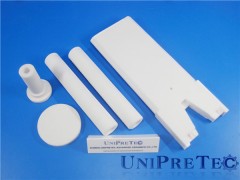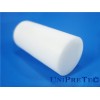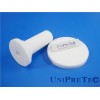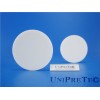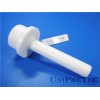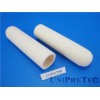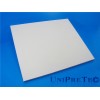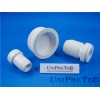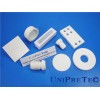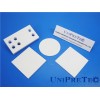MGC Manufacture
Machinable glass ceramic is melted and cast using conventional glass making techniques. It is a fluorine rich glass with a composition approaching trisilicic fluorphlogopite mica (KMg3AlSi3O10F2). Upon cooling from the melt, the glass spontaneously phase separates into fluorine rich droplets. The resulting glass has the appearance of an opal glass. Subsequent controlled heat treatment devitrifies the fluorine rich droplets causing a series of morphological changes ultimately resulting in the formation of randomly oriented, interlocked, sheet-like fluorphlogopite mica crystals within the alumino-borosilicate glass matrix. The volume percent crystalline phase after heat treatment is approximately 55% with a mean crystal size of 20 microns. It is this uniform distribution of randomly oriented mica within the parent glass that gives rise to the unique characteristics of MGC.
MGC Properties
MGC possesses a number of notable physical properties. It has a continuous use temperature of 800°C. Its coefficient of thermal expansion readily matches most metals and sealing glasses. It is nonwetting, exhibits zero porosity, and unlike ductile materials, won’t deform. It is an excellent insulator at high voltages, various frequencies and high temperatures. When properly baked out, will not outgas in vacuum environments.
MGC Machining
Machining tolerances are surprisingly tight, up to 10 microns (.0005”). It can be machined to a surface finish of less than 0.5 micron (20 microinch) and polished to a smoothness of 125 angstroms (0.5 microinch) average roughness. Most conventional machining processes can be used. Configurations are limited only by available equipment and the experience of the machinist.
MGC Sealing, Joining, metallizing
MGC can also be joined or sealed to itself and other materials in a number of ways: metallized parts can be soldered together and brazing has proven an effective method of joining the material to various metals; epoxy produces a strong joint, and sealing glass creates a vacuum tight seal. Even a straightforward mechanical joint is possible. It can be thick film metallized using inks or thin film coated using sputtering techniques.
The Bottom Line with MGC
When you need the performance of a technical ceramic — high use temperature, electrical resistivity, zero porosity — and your application demands the ready fabrication of a complicated shape — quickly, precisely, privately — consider MGC. It will lower costs and substantially reduce the time between design and actual use.

